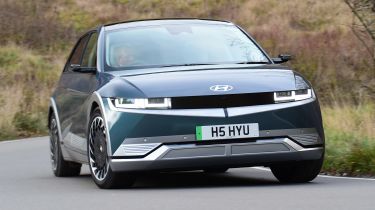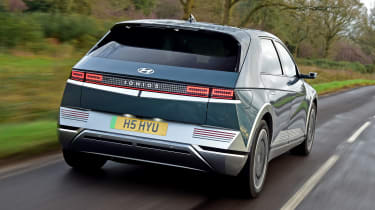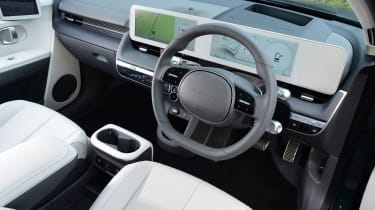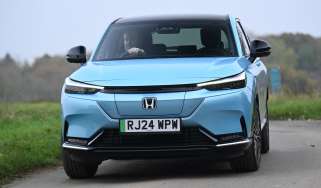Hyundai Ioniq 5 Namsan Edition 2023 review
While the Hyundai Ioniq 5 Namsan Edition is pricey, the powertrain and battery upgrades across the range are a welcome addition

Verdict
We’re not convinced that £54,000-plus versions represent the sweet spot of the revised Hyundai Ioniq 5 range, but the upgrades to the powertrain and battery have certainly been received as worthy improvements across the board. A Premium or Ultimate with the same technical mix as the car tested here would be a very capable EV and an extremely spacious, comfortable family car.
There’s hardly time to take a breath in the world of electric cars these days. Over-the-air updates are making it easier than ever for manufacturers to tweak their models on the fly, but even some of the most successful vehicles are getting hardware upgrades way more rapidly than would normally be the case with combustion-engined vehicles.
And here, to prove the point, is a new specification of Ioniq 5 – a car that’s only been on sale in the UK since 2021, when it lifted our overall New Car Awards title. The changes are pretty fundamental, too, since there’s a new, slightly larger 77.4kWh battery (up from 72.6kWh) at the upper end of the range, and a more powerful dual-motor configuration to go along with it – 321bhp, enough for a 0-62mph time of 5.1 seconds.
Hyundai has also taken this opportunity to overhaul the trim levels and specs, with some notable additions to the kit list if you’re willing to spend big. The previous entry point, SE Connect, has been dropped altogether, so the line-up now starts with Premium, priced from £43,150 when it’s equipped with a 58kWh battery and a single 168bhp motor. It’s also available with the larger pack, though, along with a more potent rear-mounted motor that now produces 225bhp (up from 214bhp), or the upgraded four-wheel-drive configuration.
Regardless of powertrain, this version features vehicle-to-load tech, allowing the Ioniq 5 to power other devices, along with part-leather upholstery, upgraded interior trim, 64-colour ambient lighting and a sliding centre console. There’s also a proposed solution to one of the Ioniq 5’s biggest flaws, its lack of a rear wiper, in the shape of a digital rear-view mirror that shows an image from a camera mounted in the rear portion of the roof.
Used - available now

2022 Hyundai
Ioniq 5
37,964 milesAutomaticElectric
Cash £20,787
2022 Hyundai
Ioniq 5
57,000 milesAutomaticElectric
Cash £18,700
2022 Hyundai
Ioniq 5
26,173 milesAutomaticElectric
Cash £19,200
2022 Hyundai
Ioniq 5
23,209 milesAutomaticElectric
Cash £19,300Ultimate sits above Premium, but it’s no longer the zenith of the line-up, thanks to the arrival of the Namsan Edition – the model we’re trying here. It costs from £54,150 and gets a full-length panoramic roof and digital side mirrors which display pictures on OLED screens mounted at either edge of the dash. It also features a heat pump as standard; this is optional on some of the other versions, although all Ioniq 5s now get a battery warmer, for more predictable charging in cold weather.
You can feel the evolution in the Ioniq 5’s cabin when you climb into a Namsan. The fundamentals of the interior haven’t changed, of course – so it’s still a really spacious place for a family to spend time, with bags of leg, knee and headroom in the rear seats. But there’s padded trim in a few more key areas, and more of the slightly utilitarian (but hard-wearing) grey plastics have been replaced too, for a more polished finish. The whole thing feels slightly tighter, too – as if Hyundai has given every bolt and joint an extra half-twist of the wrench.
On the road, the slight increase in power certainly means that any gain in weight from the modest increase in battery size isn’t enough to stop the Ioniq 5 from feeling like a car with more than enough punch in a straight line. It’s interesting, though, that Hyundai doesn’t seem to have firmed up the 5’s ride to give it dynamics that match those of its recently launched stablemate, the Ioniq 6. So in contrast with the altogether sharper saloon, the Ioniq 5 remains a car focused on comfort – and if this means the car is prone to lolloping over road undulations, and rolling a bit through corners, then so be it.
Once you get your head around that fact, and drive accordingly, it’s perfectly decent, as it was before. Just don’t expect any of the directness in steering, agility or involvement that you get with a Ford Mustang Mach-E, or even as sharp a response as you’ll find in Kia’s EV6. The Ioniq 5 is a relaxed cruiser, though - made all the more so by excellent refinement; particularly in this rear-drive version, you’re unlikely to be bothered by any electric-motor whine unless you’re stamping on the throttle.
Despite the increased power, the official range the car is up a little too – to 315 miles if you pick a Premium version with the bigger battery and rear-wheel drive – but Namsan’s extra kit count takes 20 miles off that figure. That still doesn’t look a bad number, though, for a vehicle that is considerably larger than it looks in pictures.
The jury’s out, meanwhile, on the digital side mirrors. The screens are undeniably crisp and perhaps your awareness of them would improve as you put on the miles, but initially at least, you’ll find yourself looking for the displays more than you would a conventional mirror. And the camera units themselves can’t be delivering much of an aero benefit over regular items either, since they’re in the same place as usual, and not far off the same size. It might be a handy reminder that you’ve gone for the range-topper (this feature isn’t available elsewhere, not even as an option), but in practical terms, it’s hard to see the benefit.
| Model: | Hyundai Ioniq 5 77kWh 225 2WD Namsan Edition |
| Price: | £54,150 |
| Engine: | 1x e-motor, 77kWh battery |
| Power/torque: | 225bhp/350Nm |
| Transmission: | Single-speed automatic, rear-wheel drive |
| 0-62mph: | 7.3 seconds |
| Top speed: | 114mph |
| Range: | 295 miles |
| Max charging: | 233kW DC (0-80% in 18min) |
| On sale: | Now |













